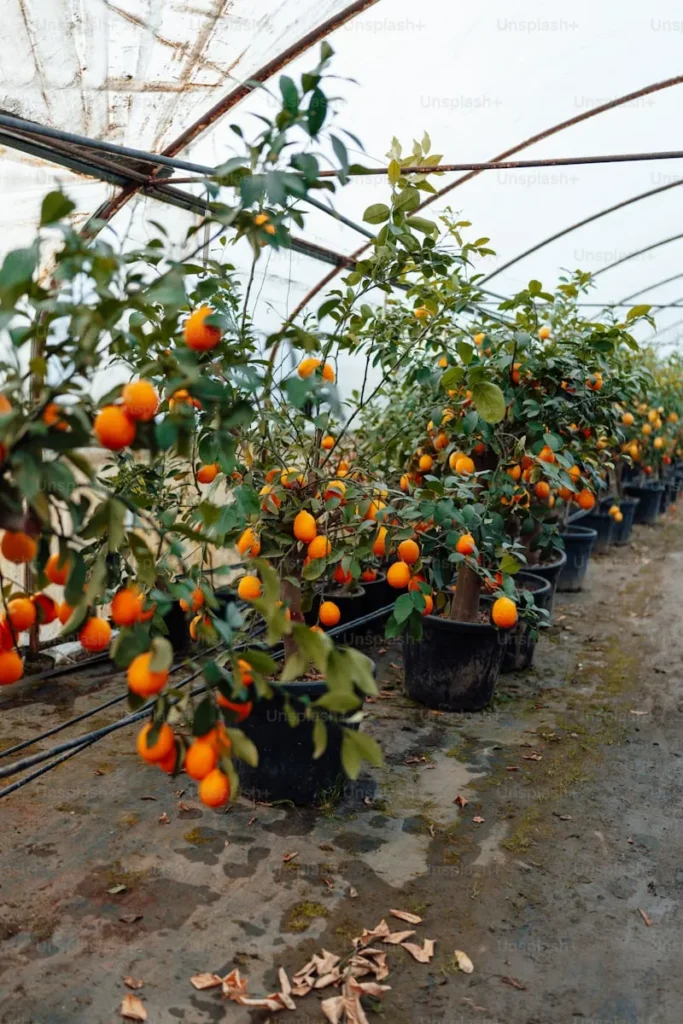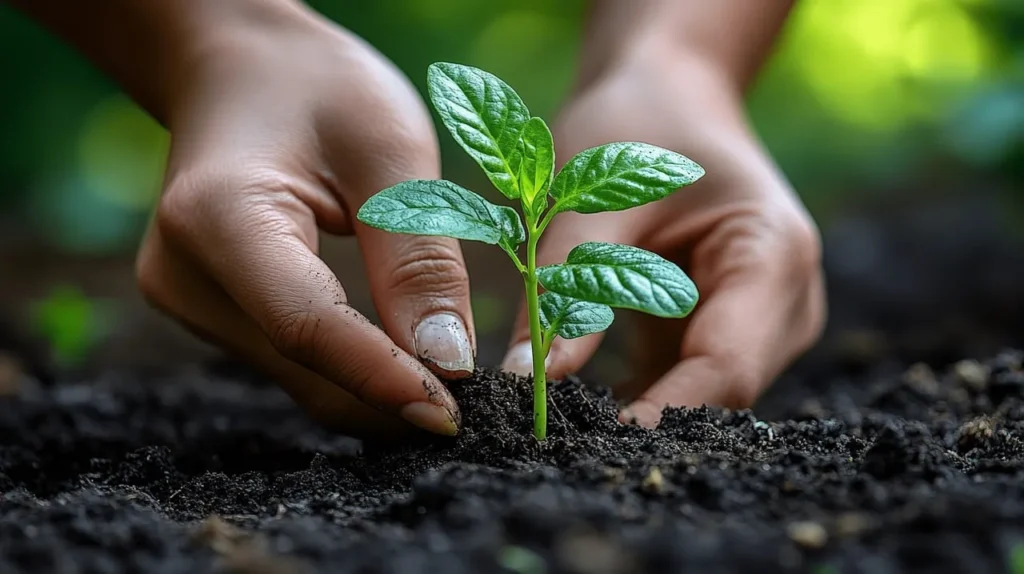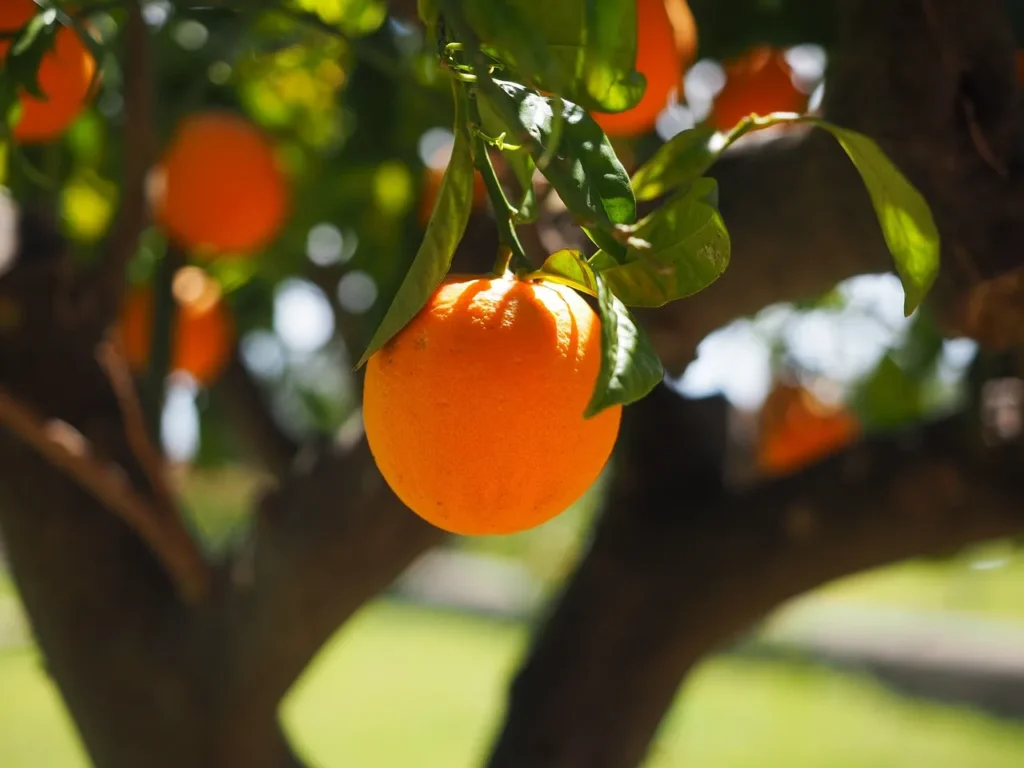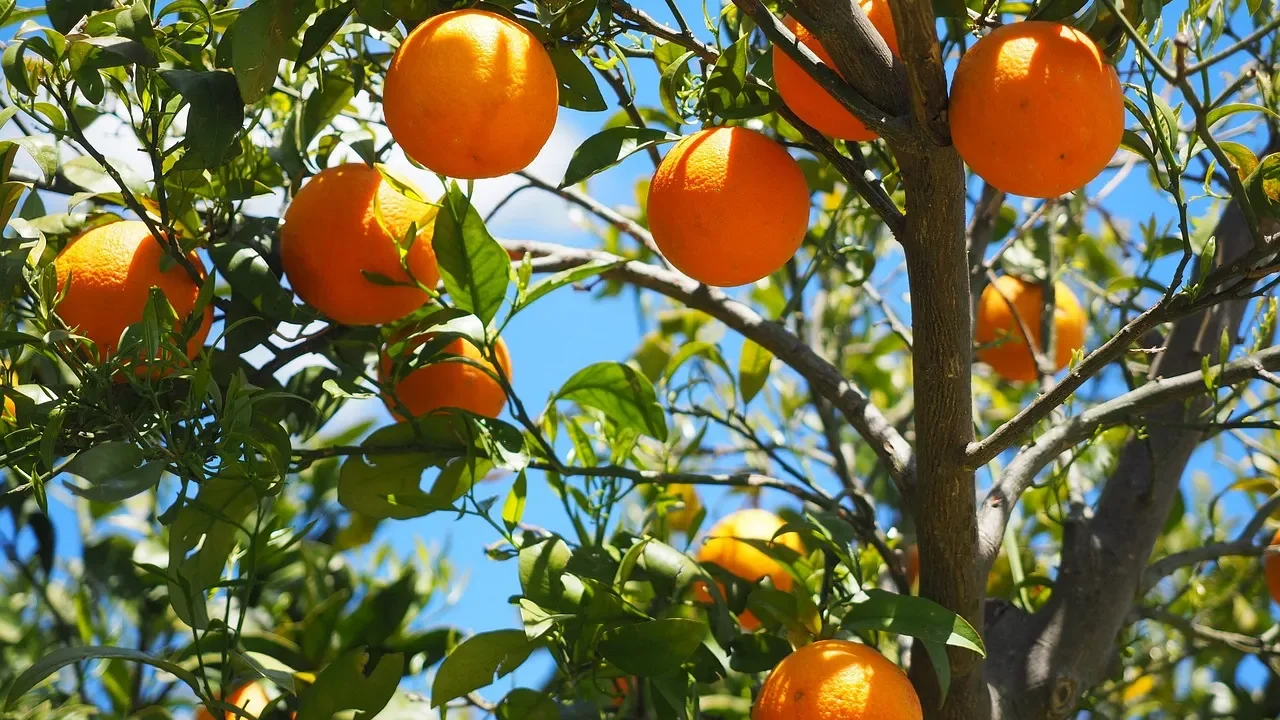Orange trees are a wonderful addition to any garden, providing fresh fruit, fragrant blossoms, and an aesthetically pleasing look. Whether you are growing oranges for fresh eating, juicing, or ornamental purposes, understanding how to plant, care for, and harvest your tree is essential for success.
Planting and growing your own oranges is a rewarding experience, and this orange tree planting guide will help you through every step. Whether you’re a beginner or an experienced gardener, this comprehensive orange tree planting guide covers everything from selecting the right variety to ensuring proper care for a healthy and fruitful orange tree. By following this orange tree planting guide, you’ll be well on your way to enjoying fresh, homegrown oranges.
Key Takeaways:
- Choosing the Right Orange Tree Variety: In this orange tree planting guide, select from varieties like Nagpur, Kinnow, or Darjeeling based on your climate and preferences.
- Ideal Planting Conditions: Orange trees need 8-10 hours of sunlight, well-draining soil, and slightly acidic pH.
- How to Plant an Orange Tree a Step-by-Step Orange Tree Planting Guide: Dig a proper-sized hole, backfill with nutrient-rich soil, and water thoroughly.
- Orange Tree Care and Maintenance a Complete Orange Tree Planting Guide: Water young trees 2-3 times per week and fertilize regularly with a balanced citrus fertilizer.
- Harvesting and Storing Oranges from Your Orange Tree Planting Guide: Harvest oranges when they are firm and brightly colored; store at room temperature or refrigerate.
- How to Increase Fruit Yield: Ensure pollination, prune properly, and avoid environmental stress for better yields.
- Can You Grow Orange Trees from Seeds?: Growing from seeds is possible but takes time 7-15 years for fruiting.
- FAQs About Orange Tree Planting Guide: Answer common questions about indoor growing, watering schedules, and common pests.
Table of Contents
Choosing the Right Orange Tree Variety
When deciding on which orange tree variety to plant, it’s important to consider factors such as climate, space, and intended use. Hasiru Agro offers a wide variety of oranges, each with its own unique characteristics. In this orange tree planting guide, select from varieties like Nagpur, Kinnow, or Darjeeling based on your climate and preferences.
Mini Orange Plant
- Description: These small trees are perfect for container gardening. The mini orange produces sweet and tangy fruits ideal for small spaces.
- Best for: Patio or indoor growing.
- Climate: Warm, sunny climates; suitable for growing indoors with enough light.
Nagpur Orange
- Description: One of the most popular varieties in India, Nagpur oranges are prized for their balanced sweetness and slight tang. Great for fresh eating or juicing.
- Best for: Fresh consumption and juicing.
- Climate: Prefers warm, sunny climates but requires frost protection in colder areas.
Mandarin Oranges
- Description: A smaller, easy-to-peel orange variety, mandarins are great for snacking and juicing. They have a sweet flavor and are commonly grown in a variety of climates.
- Best for: Snacking and small gardens.
- Climate: Tolerates cooler climates but thrives in warmer areas.
Kinnow Orange
- Description: A hybrid variety known for its juicy flesh and rich flavor. Kinnow oranges are excellent for juicing and are grown commercially due to their high yield.
- Best for: Juicing and commercial growing.
- Climate: Tropical and subtropical climates, with some tolerance to colder temperatures.
Darjeeling Orange
- Description: This variety is cultivated in the high-altitude region of Darjeeling. It is well-suited for cooler climates, producing sweet, flavorful oranges perfect for fresh eating.
- Best for: Fresh consumption and small-scale gardening.
- Climate: Grows well in high-altitude, cooler regions but needs protection from severe frost.
Recommended Products for Your Orange Tree Planting Guide
At Hasiru Agro, we offer a variety of orange trees to suit every garden. Check out our selection of high-quality orange tree saplings below:
• Mini Orange Plant: Ideal for small spaces and containers. Buy Now
• Nagpur Orange Tree: Perfect for fresh eating and juicing. Buy Now
• Mandarin Orange Tree: Easy-to-peel and sweet. Buy Now
• Kinnow Orange Tree: High-yield, perfect for juicing. Buy Now
• Darjeeling Orange Tree: Thrives in cooler climates. Buy Now
• China Orange: A widely grown and sweet variety, perfect for large orchards. Buy Now
• Bhutan Chatuki Orange: Known for its unique flavor, great for cooler climates. Buy Now

Ideal Planting Conditions
For successful orange tree growth, this orange tree planting guide recommends planting your tree in a sunny spot with 8-10 hours of direct sunlight, using well-draining soil.
Location and Sunlight
Orange trees thrive in areas with full sunlight. For optimal fruit production:
- Sunlight: Orange trees need at least 8-10 hours of direct sunlight daily. The more sunlight they receive, the better the fruit quality and yield.
- Best planting location: Plant your tree in a south-facing spot to maximize sunlight exposure.
Soil Requirements
The health of your orange tree largely depends on the quality of the soil:
- Soil Type: Loamy, well-draining soil is ideal. If your soil is heavy in clay, mix in organic matter and sand to improve drainage.
- pH Level: Maintain a slightly acidic pH of 6.0 to 7.0. You can test the pH of your soil using a home soil testing kit.

Temperature and Climate
Orange trees are suited for tropical and subtropical climates. However, certain varieties can tolerate cooler climates.
- Ideal Growing Temperatures: Orange trees grow best at temperatures between 60°F and 90°F.
- Frost Protection: Use frost blankets for trees planted outdoors in colder climates, or consider planting in containers so the trees can be moved indoors during winter months.
How to Plant an Orange Tree: Step-by-Step Orange Tree Planting Guide
Planting an orange tree requires careful attention to detail. This orange tree planting guide provides step-by-step instructions for preparing the soil, selecting the best location, and ensuring proper planting techniques. By following this guide, your tree will have the best possible start, leading to healthy growth and abundant fruit production.”
Preparing the Planting Site
Before planting, it’s important to ensure your site is well-prepared:
- Dig a Hole: Dig a hole that is twice as wide and as deep as the root ball of your orange tree.
- Amend the Soil: If your soil has poor drainage, mix it with compost or sand to improve its structure.
- Mound the Soil: In areas with heavy rainfall or poor drainage, consider planting your orange tree on a small mound to avoid waterlogging the roots.
Step-by-Step Planting Instructions
- Remove the Tree from the Pot: Gently remove the orange tree from its container, taking care not to damage the roots.
- Place the Tree in the Hole: Position the tree in the hole so that the root crown is level with the surface of the soil.
- Backfill with Soil: Fill the hole with the amended soil, pressing down gently to eliminate air pockets.
- Water Thoroughly: After planting, water the tree thoroughly to help it establish in the soil.
Growing in Pots
If you have limited space, growing orange trees in containers is an excellent option:
- Pot Size: Use a pot that is at least 18-24 inches in diameter. Ensure it has good drainage holes.
- Soil Mix: Use a citrus-specific potting mix or a mixture of loam and compost for optimal drainage and nutrients.

Orange Tree Care and Maintenance: Complete Orange Tree Planting Guide
This orange tree planting guide covers essential care practices, such as watering young trees 2-3 times per week, fertilizing regularly, and ensuring proper pruning for optimal health.
Watering Schedule
Watering is one of the most important factors in growing healthy orange trees:
- Young Trees: Water young trees 2-3 times per week to ensure the soil remains moist but not waterlogged.
- Mature Trees: Once the tree is established, water once a week or as needed depending on the weather. Ensure the tree receives about 1 inch of water weekly.
- Potted Trees: For trees grown in pots, water more frequently as container soil dries out faster.
Fertilizing Tips
Proper fertilization promotes strong growth and fruit production:
- First-Year Trees: Use a balanced fertilizer such as 10-10-10 every 6 weeks during the growing season.
- Mature Trees: Fertilize 2-3 times per year, particularly in early spring and late summer.
Pruning and Shaping
Pruning is essential for maintaining a healthy, productive orange tree:
- When to Prune: Late winter or early spring, before the new growth begins.
- How to Prune: Remove dead, damaged, or diseased branches. Thin out crowded areas to improve air circulation and light penetration.
Pest and Disease Control
Orange trees can be affected by pests such as aphids, mealybugs, and citrus leaf miners:
- Common Pests: Treat infestations early using organic insecticides or neem oil.
- Disease Prevention: Proper watering and avoiding waterlogged conditions can help prevent root rot and fungal diseases.

Harvesting and Storing Oranges from Your Orange Tree Planting Guide
In this orange tree planting guide, learn when to harvest oranges for the best flavor and how to store them for extended freshness.
When to Harvest
The right time to harvest depends on the variety:
- Nagpur and Kinnow Oranges: Typically ready for harvest in winter, from December to February.
- Mandarin Oranges: These are usually harvested between October and January.
How to Harvest
- Twist or Cut the Fruit: Gently twist the orange off the tree or cut the stem with sharp shears to avoid damaging the branches.
- Storage: Freshly harvested oranges can be stored at room temperature for 1-2 weeks or refrigerated for up to a month.
How to Increase Fruit Yield on Orange Trees
Many gardeners wonder how they can get their orange trees to produce more fruit. There are several factors that influence fruit production, including proper care, environmental conditions, and the overall health of the tree. This orange tree planting guide offers tips on boosting fruit yield through proper pollination, pruning, and reducing environmental stress.
Proper Pollination
While many orange varieties are self-pollinating, ensuring adequate pollination can significantly improve fruit yield. For outdoor trees:
- Encourage pollinators: Plant flowers that attract bees and other pollinators near your orange tree.
- Hand-pollination: If growing oranges indoors or in an area with few pollinators, use a small brush to manually transfer pollen between flowers.
Adequate Water and Nutrients
Water and nutrients are critical to a tree’s ability to produce a heavy fruit yield.
- Watering: During fruit development, increase watering slightly, ensuring the soil stays evenly moist but not waterlogged.
- Fertilization: Use a citrus-specific fertilizer rich in nitrogen and phosphorus, which encourages both foliage and fruit growth. A slow-release fertilizer applied in early spring can provide consistent nutrients throughout the growing season.
Pruning for Fruit Production
Pruning plays a major role in maximizing fruit yield:
- Remove non-productive branches: Trim away any dead or damaged branches, as well as suckers (vigorous shoots that grow from the base of the tree).
- Thin out the canopy: Thinning dense foliage helps light penetrate the tree, which improves flowering and fruiting.
Controlling Stress
Minimizing environmental stressors will help your tree focus on producing fruit:
- Frost Protection: Use frost blankets or move potted trees indoors during cold spells to avoid damage.
- Pest and Disease Control: Regularly inspect your tree for signs of pests or diseases, which can impact fruit production. Use organic pesticides or neem oil to keep your tree healthy.

Can You Grow Orange Trees from Seeds? Orange Tree Planting Guide
Growing orange trees from seeds is a common question among home gardeners. While it is possible, growing a healthy and productive orange tree from seed requires patience and specific conditions. This orange tree planting guide explains how to grow orange trees from seeds, though it takes 7-15 years for them to bear fruit.
Challenges of Growing from Seed
While planting an orange tree from seed can be a fun project, it comes with challenges:
- Time to Fruiting: Trees grown from seeds can take anywhere from 7-15 years to produce fruit, compared to grafted trees, which typically bear fruit in 3-5 years.
- Fruit Quality: Seed-grown trees often do not produce fruit that is true to the parent plant. The fruit may be less flavorful or have different characteristics than the parent orange.
- Germination Requirements: Orange seeds need warm, humid conditions to germinate. They can be started indoors but need to be transferred to a pot or the ground once they outgrow their container.
How to Plant Orange Seeds
If you’re up for the challenge, here’s how to grow an orange tree from seed:
- Extract Seeds: Remove the seeds from a fresh, ripe orange. Clean off any pulp from the seeds.
- Dry the Seeds: Let the seeds dry on a paper towel for a few days to prevent rotting.
- Plant the Seeds: Plant the seeds about 1 inch deep in a pot filled with a light, well-draining potting mix.
- Water and Cover: Water the soil lightly and cover the pot with plastic wrap to maintain moisture. Place the pot in a warm, sunny location.
- Germination: Seeds typically germinate in 4-6 weeks, though it can take longer. Once the seedlings are a few inches tall, they can be transferred to larger pots or directly into the garden.
Growing Tips
- Patience is Key: Orange trees grown from seed require patience, as they grow more slowly and take longer to produce fruit.
- Grafting Option: For faster fruiting, you can graft a branch from a mature, fruit-bearing orange tree onto your seed-grown tree after it reaches a sufficient size.

Additional Tips for Orange Tree Planting Guide
Best Time to Plant Orange Trees
Planting your orange tree in early spring or late winter is ideal, as this allows the tree to establish its roots before the growing season begins.
Common Mistakes to Avoid When Growing Orange Trees
- Overwatering: Ensure the soil is well-draining, and avoid overwatering, as it can lead to root rot.
- Incorrect Pruning: Avoid excessive pruning as it can reduce fruit production.
- Poor Soil Quality: Always check the soil’s pH and nutrient levels to ensure optimal growth conditions.
Organic Pest Control Methods for Orange Trees
- Neem Oil: An organic solution for controlling aphids, mealybugs, and spider mites.
- Companion Planting: Planting marigolds or garlic nearby can help repel pests naturally.
- Insecticidal Soap: Use this on infested areas to prevent pests from harming your tree.
Pests like aphids, mealybugs, and citrus leaf miners can cause serious damage to your orange tree if not managed properly. For more detailed, research-backed strategies on managing citrus pests, refer to the University of Florida IFAS Extension’s Citrus Pest Management Guide. This guide provides comprehensive information on identifying and controlling citrus pests.
FAQs About Orange Tree Planting Guide
Common questions addressed in this orange tree planting guide include how to grow oranges indoors, how often to water, and pest control methods.
How long does it take for an orange tree to bear fruit?
On average, an orange tree takes 3-5 years to start producing fruit. This can vary depending on the variety and growing conditions.
Can I grow orange trees indoors?
Yes, certain varieties like the Mini Orange Plant and Mandarin Oranges are well-suited for indoor growing as long as they receive sufficient sunlight (8-10 hours per day) and are planted in well-draining containers.
What is the best time to plant orange trees?
The best time to plant orange trees is in the early spring, after the risk of frost has passed. This gives the tree ample time to establish itself before the hot summer months.
How often should I water my orange tree?
Water young trees 2-3 times per week during the first year. Mature trees should be watered once per week, depending on weather conditions. Make sure the soil is moist but not soggy.
What are the most common pests for orange trees?
The most common pests include aphids, mealybugs, and spider mites. These pests can be controlled with organic pesticides or neem oil.
Conclusion
By following these guidelines, you can successfully grow and maintain healthy orange trees. Whether you’re planting Nagpur, Kinnow, or Darjeeling oranges, providing the right care and conditions will ensure a fruitful harvest. With consistent watering, proper fertilization, and pest control, your orange tree will thrive, providing fresh and delicious oranges for years to come.







